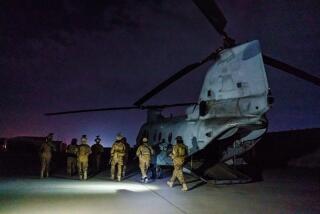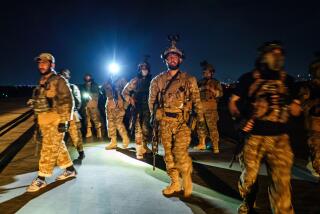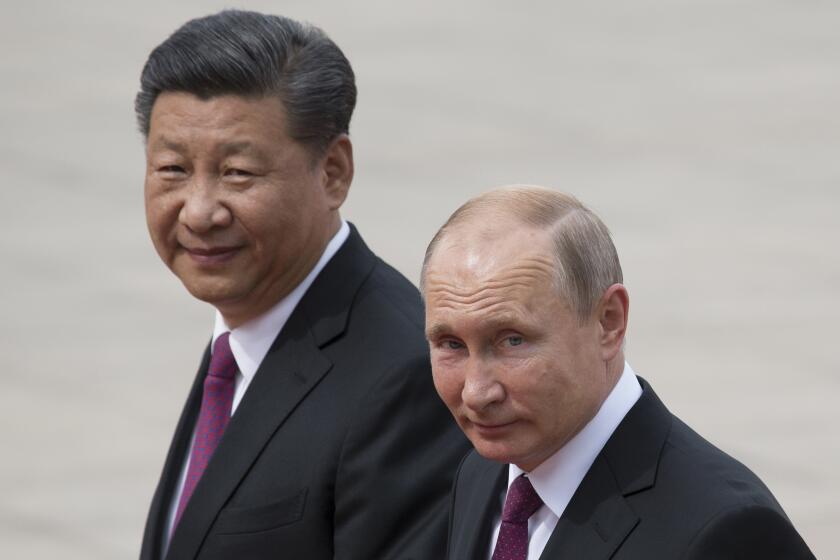Taliban Placing Hopes on Age-Old Hit-and-Hide Strategy
While American aircraft continue to pound fixed military positions in Afghanistan, its Taliban regime appears to be preparing for a protracted guerrilla conflict by retreating to mountain redoubts, private homes and mosques to await invading ground troops.
This hide-and-wait strategy, an age-old Afghan fighting method used by the moujahedeen who fought Soviet occupiers during the 1980s, has been openly described in recent statements by Taliban officials and confirmed in anecdotal accounts from independent local commanders, refugees and humanitarian aid agencies with offices in Afghan cities.
“I’d be very surprised if they give up without waging a full-scale guerrilla war,” said Rifaat Hussain, chairman of the department of defense and strategic studies at Quaid-i-Azam University in Islamabad, Pakistan’s capital. “The worst is yet to come for the alliance forces.”
Afghanistan has some of the world’s most forbidding terrain--barren, rugged land that allows armed groups to attack and quickly disappear into hidden recesses, gorges and caves. The same conditions that make finding Osama bin Laden so daunting could give the Taliban forces an enormous advantage in any direct confrontation with U.S. forces on the ground.
These conditions leave many Afghanistan specialists puzzled by comments from President Bush about “encircling the terrorists” and a similar remark by Sen. Carl Levin (D-Mich.) that referred to “tightening the noose.”
The savvy to fight in such forbidding terrain seems to come with mother’s milk for most Afghans, who are raised on tales of how their forefathers defeated a seemingly endless succession of powerful invaders.
The prospect of a guerrilla campaign looms after two weeks of U.S.-led airstrikes that have generated few signs of any weakening of the Taliban’s resolve.
“Their military capability hasn’t been destroyed, but more importantly, their spirit is intact,” said Kamal Matinuddin, a retired Pakistani general who has written extensively on the Taliban. “The hard line will take to the hills and do hit-and-run from the countryside.”
Guerrilla tactics worked spectacularly for the CIA-supplied moujahedeen against the massive presence of Soviet troops in the 1980-89 war of resistance. Under very different circumstances, such tactics were used by the Viet Cong to humble American troops in Vietnam.
But how effective they would be against American hit-and-run tactics employing elite Special Forces units remains to be seen. The first announced limited U.S. ground action occurred Saturday, when more than 100 American troops were dropped into the airport at Kandahar, the Taliban stronghold in southern Afghanistan, for a seven-hour operation.
The still-evolving Taliban response to the American attacks has been to retreat and go underground. Taliban officials have admitted that their government functions have been crippled by the air attacks, which have destroyed the country’s telephone system and damaged military command centers.
To replace some of their hardware, they have taken to raiding international assistance groups.
Deputy Coordinator for the United Nations Antonio Donini told reporters in Islamabad on Saturday that privately financed mine-clearance groups affiliated with the U.N. have lost 80 vehicles to marauding Taliban fighters during the past two weeks and that several U.N. offices have been attacked and looted.
“The ability of the U.N. to continue to work in Afghanistan is rapidly deteriorating,” he said.
Also Saturday, the international relief agency Mercy Corps, which operates medical clinics and drought relief programs in the Afghan provinces of Kandahar and Helmand, said Taliban fighters had seized some of its offices and commandeered two of its aid trucks seeking to blend into the civilian population.
At a U.N. news conference Saturday, other aid agencies said they have witness reports of Talibs settling into civilian residences in Kandahar and other locales after expelling their occupants.
“While their traditional command structure appears to be unraveling,” said one Pakistan-based aid official, “Taliban is taking refuge in homes, mosques and other civilian quarters.”
At a news conference in Islamabad on Friday, Taliban Ambassador Abdul Salam Zaeef said the Taliban was preparing “for a long war” by stockpiling and hiding munitions and retreating from identifiable military positions. As a result of these moves, Zaeef said, Taliban military casualties have so far been minimal. All the senior Taliban leadership, he said, is safe, as is the regime’s notorious guest, Bin Laden.
“It is very interesting that we have had 14 days of bombing and Special Forces on the ground but haven’t seen the Taliban retaliate in any way,” Hussain said. “They are lying low, preserving their energies and resources, waiting to wage a guerrilla war.”
The language used by Taliban commanders remains defiant.
“We will retreat to the mountains and begin a long guerrilla war to reclaim our pure land from infidels and free our country again like we did against the Soviets,” said Paktia province commander Jalaluddin Haqqani, a Taliban ally in the border area south of Kabul, the Afghan capital. Haqqani’s comments were published in a long interview with the News, a Pakistani newspaper.
Other commanders who operate independently or who are openly opposed to the Taliban claim that the American air attacks have been more effective than the Taliban will admit.
Some commanders from Nangarhar province, interviewed in Peshawar, Pakistan, on Thursday, said American air actions near Jalalabad, a key city in eastern Afghanistan, have successfully driven Taliban forces into the nearby hills.
“The only time you see them is when they come into town in their Datsun pickups with a machine gun mounted on the back,” said one of the commanders, who claimed to have 120 fighters under his leadership. “They do their shopping in the market, and then they disappear.”
Although the air attacks appear to have solidified support for the Taliban in some areas, there have been several reports that some civilians, fearful that their villages and neighborhoods will be bombed, have asked the Taliban to leave.
“The Taliban has lost so much popular support,” said Rostom Sherzad, who claims to have 120 fighters under his command in the Khugiani district near Jalalabad. “When they come to a village, the people ask them to leave because they don’t want to become a target.”
Sherzad traveled clandestinely to Pakistan recently to meet with other local commanders loyal to a Jalalabad warlord, Haji Mohammed Zaman.
More to Read
Start your day right
Sign up for Essential California for news, features and recommendations from the L.A. Times and beyond in your inbox six days a week.
You may occasionally receive promotional content from the Los Angeles Times.






